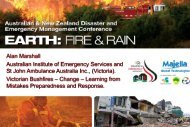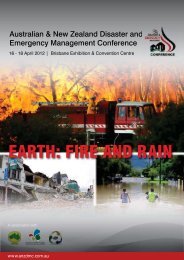Book of Abstracts 2013 - Australian and New Zealand Disaster ...
Book of Abstracts 2013 - Australian and New Zealand Disaster ...
Book of Abstracts 2013 - Australian and New Zealand Disaster ...
Create successful ePaper yourself
Turn your PDF publications into a flip-book with our unique Google optimized e-Paper software.
The project included a range <strong>of</strong> leading practice approaches: Mapping <strong>of</strong> heat flux using Geographic Information<br />
Systems providing a pre site assessment <strong>of</strong> the bushfire risk <strong>and</strong> a robust decision support system for field assessors<br />
Detailed site inspections that included BPAD accredited staff, ecologists <strong>and</strong> fire engineers<br />
Establishment <strong>of</strong> a Shelter in Place - engineered to meet AS3959 requirements, supplemented by Asset Protection<br />
Zones, improved l<strong>and</strong>scaping <strong>and</strong> emergency management procedures. Cradle-to-grave management - providing a<br />
unique opportunity to capture data on the upgrade <strong>of</strong> a large sample <strong>of</strong> vulnerable buildings.<br />
This project involved the detailed on-site assessment <strong>and</strong> subsequent engineering upgrades for over 300 vulnerable<br />
schools. As a result, a unique opportunity was identified; to capture the required upgrades to a variety <strong>and</strong> great<br />
number <strong>of</strong> class 9 buildings, <strong>and</strong> across a range <strong>of</strong> Bushfire Attack Level (BAL) zones.<br />
This paper will examine the outcomes <strong>of</strong> the project, including the typical upgrades across each BAL zone, the areas<br />
most likely to cause defect <strong>and</strong> maintenance issues, <strong>and</strong> the resulting cost (based on a per student scale) in each BAL<br />
zone.<br />
Ms Kate Fitzgerald<br />
International Fellow, East-West Center<br />
Hurricane S<strong>and</strong>y – Can we achieve both growth <strong>and</strong> resilience?<br />
Do we need to redefine disasters within our communities? Do we need to increase our acceptance <strong>of</strong> risk? Can we<br />
achieve both growth <strong>and</strong> resilience? Hurricane S<strong>and</strong>y was a unique event due to the scale <strong>of</strong> the disaster along the<br />
United States East Coast <strong>and</strong> the significant <strong>and</strong> sustained impact upon critical infrastructure throughout the disaster<br />
affected area resulting in an unprecedented, wide-spread activation <strong>of</strong> the US emergency management structure. This<br />
paper explores disaster management through the concept <strong>of</strong> reflexive modernization <strong>and</strong> provides a first-h<strong>and</strong> account<br />
<strong>of</strong> the effectiveness <strong>of</strong> pre-impact decision-making by politicians <strong>and</strong> <strong>of</strong>ficials <strong>and</strong> the ineffectiveness <strong>of</strong> post-impact<br />
decision-making relating to immediate relief <strong>and</strong> recovery priorities. During Hurricane S<strong>and</strong>y I was deployed by the<br />
American Red Cross to Long Isl<strong>and</strong> to assist in the immediate response <strong>and</strong> recovery effort in that area <strong>and</strong> was able to<br />
see the tension between growth <strong>and</strong> risk within modern societies <strong>and</strong> how governments <strong>and</strong> communities are<br />
responding to that. The notorious gas shortages following Hurricane S<strong>and</strong>y is an example <strong>of</strong> how continued economic<br />
growth has resulted in the production <strong>of</strong> unpredictable risks <strong>and</strong> hazards in the face <strong>of</strong> which governments <strong>and</strong> nongovernment<br />
organisations are required to respond. Hurricane S<strong>and</strong>y provides not only important lessons learned from<br />
an operational perspective but can be explored as a new paradigm in which to view disaster management <strong>and</strong> to<br />
redefine our policies, politics <strong>and</strong> institutions that support our response to disasters.<br />
Dr Jessica Freame<br />
Manager, Fire Recovery Unit, Department <strong>of</strong> Planning <strong>and</strong> Community Development<br />
Co Authors - Mr Sam Redlich, Project <strong>and</strong> Council Liaison Manager, Department <strong>of</strong> Planning <strong>and</strong> Community Development.<br />
Ms Bec Nicoll, Community Engagement Coordinator, Department <strong>of</strong> Planning <strong>and</strong> Community Development.<br />
After the Crisis: Recovery Four Years On<br />
The devastating 2009 Victorian bushfires required a massive response from Government, which was exemplified by the<br />
establishment <strong>of</strong> the Victorian Bushfire Reconstruction <strong>and</strong> Recovery Authority (VBRRA). At its height, VBRRA had<br />
close to 200 staff <strong>and</strong> was embedded within bushfire-affected communities <strong>and</strong> Government. While VBRRA ceased<br />
operations on 30 June 2011, almost two <strong>and</strong> a half years after the bushfires, the process <strong>of</strong> recovery for affected<br />
communities continued. This paper will consider the State Government role in 2009 bushfire recovery from the closure<br />
<strong>of</strong> VBRRA until the 4th anniversary <strong>and</strong> beyond. It will look at the critical recovery issues that emerged in the two to






